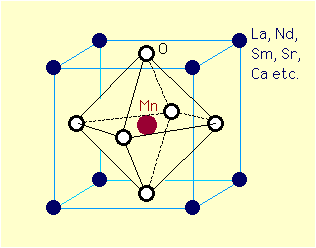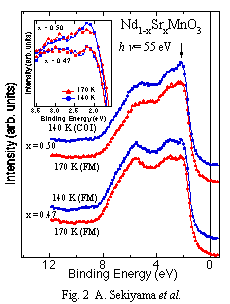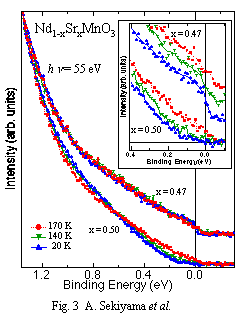High-resolution photoemission study of Perovskite Mn
oxides: Opening of the charge-ordering gap
(Collaborating with Prof. H. Kuwahara
in Sophia University and Prof. Y. Tokura in JRCAT and University
of Tokyo)
Physical Review B vol.59,
p.15528 (1999).
Electronic structures of the charge-ordering manganite
Nd1-xSrxMnO3 (x~0.5) have been
studied by resonant and high-resolution photoemission. The Mn
2p-3d (Nd 3d-4f) resonant photoemission confirmed the Mn 3d (Nd
4f) states hybridized with the O 2p states. The high-resolution
Mn 3p-3d resonance spectra show a clear transition from the metal
to the charge-ordered insulator for x=0.5 upon cooling while
a Fermi cut-off is seen for x=0.47 at all temperatures, suggesting
that the transition is induced by a subtle competition between
the charge-ordering instability and the double-exchange interaction.
Introduction
 The manganese-based
perovskite oxides have attracted great
interest due to the recent discovery of colossal magnetoresistance.
These magnetic and transport properties have been explained by
the double-exchange (DE)
mechanism. Recently, it has been pointed
out that the dynamic JT effect is important in addition
to the DE interaction. On the other hand, it has been found
that some perovskite manganites with commensurate values of x,
such as Nd0.5Sr0.5MnO3,
undergo a transition from a ferromagnetic metal (FM) to a charge-ordered
insulator (COI) upon cooling. The
FM-COI transition is accompanied by a spin- and orbital-ordering,
and it is also known that a CE-type antiferromagnetic structure
is realized in the COI phase. In this paper, we report on resonance and high-resolution
photoemission studies on Nd1-xSrxMnO3
with x=0.47 and 0.5 in order to clarify
the electronic structures in the whole valence-band region and
near the Fermi level (EF). Nd0.5Sr0.5MnO3
(x = 0.5) undergoes a PI-FM transition at Tc~255 K and a FM-COI
transition at TCOI~158 K upon cooling. Nd0.53Sr0.47MnO3
(x = 0.47) is in the FM phase below Tc~275 K and does not exhibit
any COI transition.
The manganese-based
perovskite oxides have attracted great
interest due to the recent discovery of colossal magnetoresistance.
These magnetic and transport properties have been explained by
the double-exchange (DE)
mechanism. Recently, it has been pointed
out that the dynamic JT effect is important in addition
to the DE interaction. On the other hand, it has been found
that some perovskite manganites with commensurate values of x,
such as Nd0.5Sr0.5MnO3,
undergo a transition from a ferromagnetic metal (FM) to a charge-ordered
insulator (COI) upon cooling. The
FM-COI transition is accompanied by a spin- and orbital-ordering,
and it is also known that a CE-type antiferromagnetic structure
is realized in the COI phase. In this paper, we report on resonance and high-resolution
photoemission studies on Nd1-xSrxMnO3
with x=0.47 and 0.5 in order to clarify
the electronic structures in the whole valence-band region and
near the Fermi level (EF). Nd0.5Sr0.5MnO3
(x = 0.5) undergoes a PI-FM transition at Tc~255 K and a FM-COI
transition at TCOI~158 K upon cooling. Nd0.53Sr0.47MnO3
(x = 0.47) is in the FM phase below Tc~275 K and does not exhibit
any COI transition.
Results and Discussion
 Mn 2p-3d
and Nd 3d-4f resonance photoemission of single crystal samples
was performed at 300 K at beam line BL-2B of the Photon Factory
(PF). The energy resolution was <0.8 and ~1.0 eV, respectively.
High-resolution photoemission measurements (hν = 55 eV) were
done at beam line BL-3B of PF at various temperatures with the
total energy resolution of ~45 meV.
Mn 2p-3d
and Nd 3d-4f resonance photoemission of single crystal samples
was performed at 300 K at beam line BL-2B of the Photon Factory
(PF). The energy resolution was <0.8 and ~1.0 eV, respectively.
High-resolution photoemission measurements (hν = 55 eV) were
done at beam line BL-3B of PF at various temperatures with the
total energy resolution of ~45 meV.
Photoemission spectra of Nd0.5Sr0.5MnO3
in the entire valence-band region are shown in Fig. 1. The spectra
taken at hν = 978 (642) and 964 eV (636 eV) correspond to the Nd 3d-4f (Mn
2p-3d) resonance-maximum and -minimum, respectively. A two-peak
structure is observed at ~3.5 and ~7 eV in the Nd 3d-4f resonance-maximum
spectrum, which is characteristic of a localized 4f3
(Nd3+) ground state. From a cluster model analysis,
the unhybridized f-hole and ligand-hole energies, and the effective
transfer integral have been estimated as 4.7, 5.1, and 1.35 eV,
respectively. These results indicate that the O 2p states are
located near the bare Nd 4f levels and the Nd 4f-O 2p hybridization
effect in the final states is strong. In this way, the contribution
of the rare-earth 4f states should be really taken into account
for interpreting the valence band structures. In the Mn 2p-3d
resonant spectra (hν = 640 and 642 eV), Mn 3d-derived spectral features
appear at 0.6, 2.3, and 6.7 eV. The 0.6 eV shoulder and 2.3 eV
peak, which are also clarified in the spectrum taken at hν = 55 eV, are ascribed
to the eg and t2g states, respectively.
The 6.7 eV peak corresponds to the t2g states strongly
hybridized with the O 2p states.
 Figure 2 shows the temperature-dependent
spectra of the x=0.47 and 0.5 samples taken at 55 eV. There are structures at 0.6, 2.3, 3.0, and 5.6 eV in
all the spectra. Comparing the spectra with those in Fig. 1, we
conclude that the structures at 3.0 and 5.6 eV mainly originate
from the O 2p states, which are not prominent in the spectra at
the higher photon-energy excitations. For x=0.47, there is no remarkable difference in the
spectra between 140 and 170 K, both in the FM phase. As for x=0.5,
the gross feature of the spectrum at 140 K is similar to that
at 170 K. However, the 2.3 eV structure at 140 K (indicated by
an arrow in Fig. 2) is narrower particularly on the lower binding
energy side (2.0-1.6 eV) as revealed in the inset. Furthermore, the narrowing of the 2.3 eV structure
itself is more distinct for x=0.5 than for x=0.47. We consider
that the narrowing is caused by the localization of the t2g
states due to the FM-COI transition. It is known that the t2g
levels are split into two levels by the JT distortion, which is
thought to become larger in the COI phase as suggested from the
temperature dependence of the lattice parameters. If the energy-splitting
in the t2g levels is remarkably larger in the COI phase
than in the FM phase, the 2.3 eV structure would broaden at 140
K. In fact, such a broadening is not observed. Nd0.5Sr0.5MnO3
has the orthorhombic O' structure even in the FM phase, suggesting
that t2g levels are split in contrast to the case of
the FM phase of rhombohedral La0.5Sr0.5MnO3.
Therefore it is reasonable to conclude that the t2g
levels are already split in the FM phase and that the energy-splitting
does not change much between the two phases.
Figure 2 shows the temperature-dependent
spectra of the x=0.47 and 0.5 samples taken at 55 eV. There are structures at 0.6, 2.3, 3.0, and 5.6 eV in
all the spectra. Comparing the spectra with those in Fig. 1, we
conclude that the structures at 3.0 and 5.6 eV mainly originate
from the O 2p states, which are not prominent in the spectra at
the higher photon-energy excitations. For x=0.47, there is no remarkable difference in the
spectra between 140 and 170 K, both in the FM phase. As for x=0.5,
the gross feature of the spectrum at 140 K is similar to that
at 170 K. However, the 2.3 eV structure at 140 K (indicated by
an arrow in Fig. 2) is narrower particularly on the lower binding
energy side (2.0-1.6 eV) as revealed in the inset. Furthermore, the narrowing of the 2.3 eV structure
itself is more distinct for x=0.5 than for x=0.47. We consider
that the narrowing is caused by the localization of the t2g
states due to the FM-COI transition. It is known that the t2g
levels are split into two levels by the JT distortion, which is
thought to become larger in the COI phase as suggested from the
temperature dependence of the lattice parameters. If the energy-splitting
in the t2g levels is remarkably larger in the COI phase
than in the FM phase, the 2.3 eV structure would broaden at 140
K. In fact, such a broadening is not observed. Nd0.5Sr0.5MnO3
has the orthorhombic O' structure even in the FM phase, suggesting
that t2g levels are split in contrast to the case of
the FM phase of rhombohedral La0.5Sr0.5MnO3.
Therefore it is reasonable to conclude that the t2g
levels are already split in the FM phase and that the energy-splitting
does not change much between the two phases.
 Temperature
dependence of the spectra near EF is shown in Fig.
3. In all the spectra, spectral intensities decrease toward EF.
In the case of x = 0.47,
the intensity at EF is finite at all temperatures and
furthermore a clear Fermi cut-off is observed at 20 K. It should be noted that the spectra for x=0.47 have
no essential temperature dependence, which is consistent with
that Nd0.53Sr0.47MnO3 is in the
same FM phase irrespective of the temperature. Contrary to this, the spectra of x =
0.5 have shown distinct temperature dependence between 140 and
170 K. The spectrum at 140 K is suppressed from EF
to 0.4 eV and rather enhanced from 0.7 eV to 1.2 eV compared to
that at 170 K. At EF,
the intensity vanishes at 140 K whereas that at 170 K is weak
but finite, clearly indicating the opening of the charge-ordering
(CO) gap. From the metallic behavior
for x = 0.47 and the clear FM-COI transition for x = 0.5, we consider
that the transition is induced by a subtle competition between
the CO instability, which originates from the commensurate value
of x = 1/2, and the DE interaction. Namely, the DE interaction overcomes the CO instability
for incommensurate x=0.47, making the eg band-width
large enough to become metallic. From
the spectra in the COI phase, the CO gap (the binding energy
of the threshold of finite photoemission intensity) is estimated as about 100 meV at 20
K.
Temperature
dependence of the spectra near EF is shown in Fig.
3. In all the spectra, spectral intensities decrease toward EF.
In the case of x = 0.47,
the intensity at EF is finite at all temperatures and
furthermore a clear Fermi cut-off is observed at 20 K. It should be noted that the spectra for x=0.47 have
no essential temperature dependence, which is consistent with
that Nd0.53Sr0.47MnO3 is in the
same FM phase irrespective of the temperature. Contrary to this, the spectra of x =
0.5 have shown distinct temperature dependence between 140 and
170 K. The spectrum at 140 K is suppressed from EF
to 0.4 eV and rather enhanced from 0.7 eV to 1.2 eV compared to
that at 170 K. At EF,
the intensity vanishes at 140 K whereas that at 170 K is weak
but finite, clearly indicating the opening of the charge-ordering
(CO) gap. From the metallic behavior
for x = 0.47 and the clear FM-COI transition for x = 0.5, we consider
that the transition is induced by a subtle competition between
the CO instability, which originates from the commensurate value
of x = 1/2, and the DE interaction. Namely, the DE interaction overcomes the CO instability
for incommensurate x=0.47, making the eg band-width
large enough to become metallic. From
the spectra in the COI phase, the CO gap (the binding energy
of the threshold of finite photoemission intensity) is estimated as about 100 meV at 20
K.
Finally we refer
to the temperature dependence of the spectra within the FM phase
for the perovskite manganese oxide. Our
spectra for x=0.47 have little temperature dependence while spectra
of La1-xAxMnO3 (A = Sr or Ca)
show remarkable temperature dependence. This experimental discrepancy
seems to be related to the difference in the crystal structure
between the O' phase (Nd1-xSrxMnO3)
and the rhombohedral phase (La1-xSrxMnO3).
For the rhombohedral manganites, a neutron diffraction study suggests
a change of polaron networks with temperature. In the case of
Nd1-xSrxMnO3, however, we consider
that the "intermediate polaron" can not be formed because
of the larger GdFeO3-type distortion, and consequently
there is no temperature change of the polaron networks. It is
understandable that the "temperature-independent" spectra
of Nd1-xSrxMnO3 within the FM
phase are due to the absence of the change of the polaron networks
in constast to the La1-xAxMnO3.
- Akira Sekiyama




